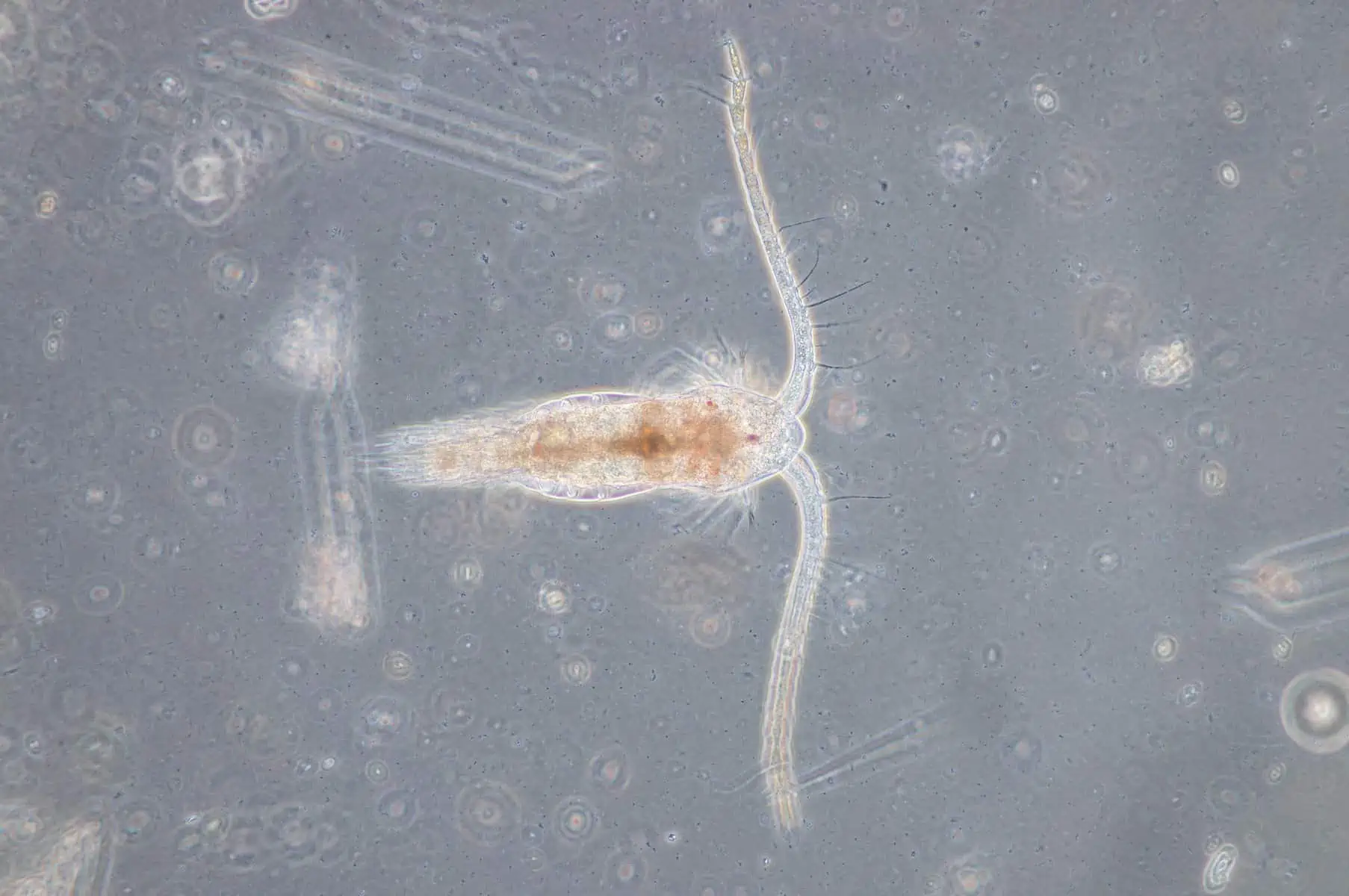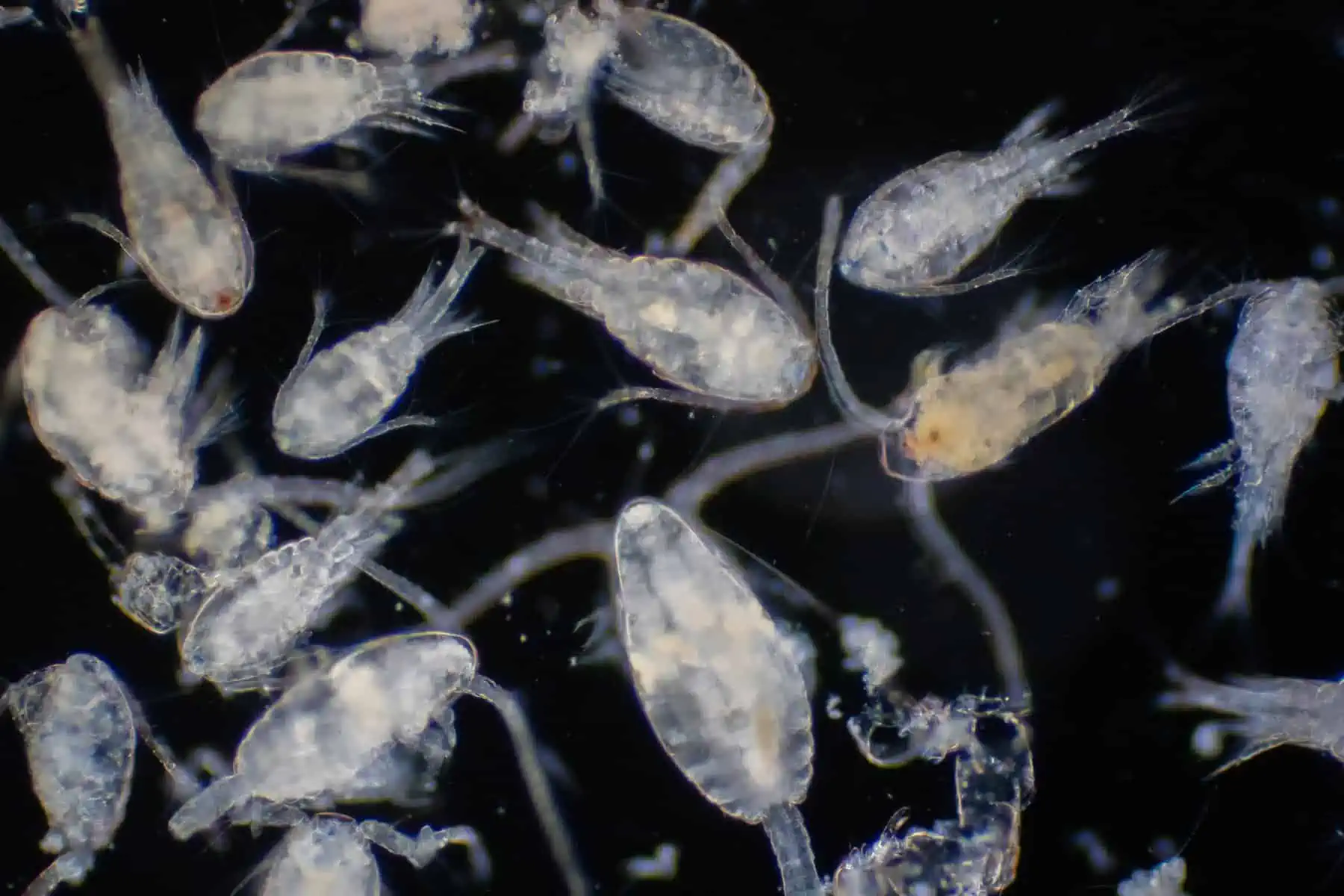One day recently, I was about to feed my fish when I noticed a whole bunch of tiny little creatures on the glass.
I realized that the critters were copepods. But how did they get into my aquarium? Could these tiny bugs harm my fish? And what benefits can their presence bring to my fish tank?
Keep reading for the low-down on copepods in the aquarium and learn what to do about them!
What Are Copepods?
Copepods are tiny crustaceans that you’ll find in pretty much any habitat, from deep water marine environments to freshwater streams, rivers, and swamps. You’ll even find some species of copepods living in water barrels and empty garden containers.
These tiny creatures are vital to the marine ecosystem, providing an essential food source for small fish, corals, and invertebrates.
Types of Copepods
There are thought to be somewhere between 7,000 to 20,000 different species of copepods living in varied habitats from the rainforest to the deep ocean.
Within the huge group’s eight orders are three dominant copepod groups in terms of species numbers and biomass: calanoids, harpacticoids, and cyclopoids.
Most of these groups inhabit sunlit, shallow waters, where they live on phytoplankton. Once fat and nutrient-rich, the copepods provide a valuable food source for other creatures, from small fishes to huge whales.
Calanoids
Calanoids are physically the largest and most common copepods and live in saltwater environments. In fact, there are thought to be more calanoids in the oceans by weight than any other plankton.
Calanoid copepods are especially popular with juvenile fish and larvae, as they are easy to eat and digest. However, the calanoid’s mostly pelagic habit makes them extremely difficult to culture in captivity in large numbers.
Harpacticoids
Harpacticoids are pelagic in habit as larvae, eventually settling on the ocean substrate and spending their adult lives there.
These copepods eat detritus and microalgal film and are an important part of mud and sand communities, where they are a valuable food source for small fishes, such as mandarins and hydroids.
Harpacticoids are hardy creatures that are one of a handful of copepod species that are relatively easy to raise in the aquarium and will readily establish breeding populations in your marine or reef tank.
Cyclopoids
Cyclopoids are omnivorous species of copepod that feeds on fine particles of organic waste and bacteria that they find in the water column.
These copepods live in semi-enclosed or closed water bodies and are able to withstand extreme conditions of drought and freezing weather. Some species of cyclopoid inhabit freshwater, while others live in the marine environment.
Like the majority of copepod species, cyclopoids are mainly pelagic, although there are some bottom-dwelling varieties.
If you want to produce a large quantity of copepods for your livestock, cyclopoids are the most productive. Although smaller than other species, female cyclopoids typically produce around 650 eggs over their brief lifetime.
So, you can see that keeping a solid copepod colony ensures a constant supply of copepods for your juvenile fish and fry.
Why Are Copepods Beneficial to Aquariums?
Although they go unnoticed until they appear on your glass, copepods form an essential element of the microscopic side of your aquarium.
How so?
Cleanup Crew
Well, the big thing about copepods is that they eat microalgae, fish waste, and detritus, making them essential members of your fish tank cleanup crew.
Okay, so one copepod working alone won’t make much difference, but many thousands can! In fact, in an average-sized aquarium, did you know that you can have a population of over 100,000 copepods
Food Source for Fish and Corals
The fact that copepods love to munch on algae makes them highly nutritious. That’s because the algae use nutrients carried in the water to grow. The copepods gobble up the algae, which makes them rich in essential fatty acids.
So, you can see that a diet supplemented by well-fed copepods is excellent for boosting coral and fish growth and stimulating vibrant colors.
Fussy feeders can be tempted by juicy copepods, so if you have Mandarin goby in your marine collection, copepods are an excellent food source.
Refugium
Many hobbyists like to run a refugium to produce macroalgae that can control nuisance algae by competing with it for nutrients in the aquarium.
Refugiums can be used to provide copepods with a safe breeding ground. The tiny creatures return the favor by helping to keep the macroalgae clean and free from detritus.
What Do Copepods Look Like?

Copepods can be seen with the naked eye, usually as tiny white dots that you’ll see skipping around on the rocks in your tank and on the viewing panes.
These little, flea-like creatures measure just 1 to 2 mm in length and have teardrop-shaped bodies with large antennae on their head. The animal’s skeleton is armored for protection against predators.
Copepods have four pairs of appendages that they use for walking and swimming, and they have one median nauplius eye.
How Did Copepods Get Into My Fish Tank?
Usually, copepods find their way into your aquarium on live rocks or sand in a marine tank or on plants, green algae, and stones in a freshwater setup.
Although you won’t notice the copepods at first, they will rapidly multiply and grow when there’s plenty of food for them and warm water.
Where Can I Buy Copepods?
There are a few suppliers that sell various species of copepods, most of them online. However, you can often buy the creatures from specialist marine fish stores.
Are Copepods on Glass a Good Sign?
Copepods are a good sign for your fish tank, offering many benefits to the aquarium.
That said, some fish keepers are still unsure whether copepods in the tank are a good thing. To dispel any doubts, here are the main benefits of having copepods in your fish tank:
- Copepods are a protein-rich source of food for fish. In fact, a specific fatty acid the copepods contain is essential for several fish species.
- Copepods make an excellent addition to your cleanup crew, helping to keep the tank free from algae and debris and taking some of the burden from your filtration system.
- Copepods are incredibly cheap to buy and introduce to your fish tank. The creatures grow and reproduce rapidly, quickly filling your tank with thousands of tasty, nutritious bites for your fish.
So, if you have copepods on your glass, that’s a sign your aquarium is healthy.
Can You Have Too Many Copepods?

We don’t think you can have too many copepods!
These tiny creatures are a beneficial food source for your fish, especially fussy feeders.
In addition, a healthy population of copepods helps to keep your fish tank clean and tidy by grazing on microalgae and general detritus.
FAQs
In this part of our guide to copepods on your aquarium glass, we answer some of the most frequently asked questions about these fascinating creatures.
Q: Are Copepods Harmful to Humans?
A: Yes, although copepods are excellent news for your fish, they can harm humans if you consume them.
So, we’d like to think that you’re not about to help yourself to a cupful of copepods from your fish tank! But if you drink tap water containing copepods infected with D. medinensis larvae, you can find yourself in trouble.
The nematode Dracunculus medinensis causes Guinea worm disease. When the ingested copepods decompose, the worm larvae enter the victim’s stomach and intestine wall.
Never be tempted to drink water from a stream or from your garden water butt; it could contain parasites that will make you sick!
Q: What Do Copepods Do To Fish?
A: Copepods are not harmful to your fish. In fact, these tiny creatures are a fabulous source of nutrition for your fishy friends.
Q: Do Copepods Clean Your Tank?
A: Copepods graze on microalgae and general detritus, helping to clean your tank. However, copepods won’t make much of a dent in a badly algae-infested tank, although they will help to reduce it.
Q: How Long Do Copepods Live?
A: Like many tiny critters, copepods don’t live long, having a lifespan of only seven months to one year.
Final Thoughts
Did you enjoy our guide on copepods on your aquarium glass viewing panels? If you found the information helpful, please share the article with other fish fanatics!
Copepods often arrive in your tank with live rock and sand or on freshwater stones, green algae, and aquatic plants.
These tiny, harmless creatures can help to keep your tank clean by eating algae and detritus, and they provide an excellent, nutrient-rich food source for your fish.
Do you think copepods in your aquarium are good or bad? Tell us your opinion in the comments box below!


